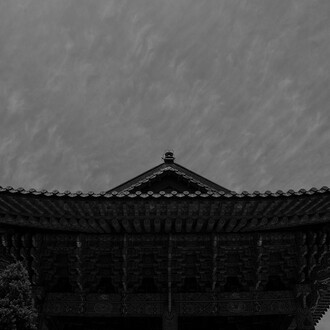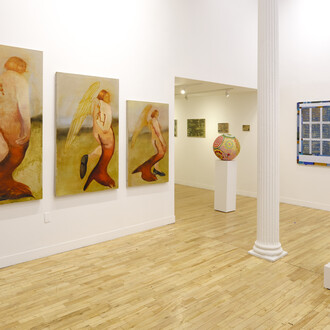In works like The Card (El Cordon De Plata) and Whenever and Wherever, Mague Brewer is at her most effective—suggesting uneven horizontal and vertical constituents of the pictureplane that bleed and float.
The act of suggestion, not pointing, is here more pronounced than those works where straightforward silhouettes come to the fore (e.g., Brewer's outlines of overlapped faces or straightforward orbular eyes with penetrating gazes). In her more abstract works, Brewer becomes something of a dramatist-cum-field-painter, the shape of doors-without-knobs and windows-without-locks-and-lifts contiguous with their monochrome foreground (e.g., a bleary azure-topaz blue or cerulean green).
There are then Newman-esque "zips", painted distinctly and sometimes hunched above one another, which takes the suggestion-game to new territory; this is now the domain of perspectival evanescence: a residual plane into which a cascade of elements are ushered and absorbed like quivering magnets. These “zips” are sometimes sun-strained hay-yellow but are far more gestural than the mathematical sublime of Newman’s zips, the latter having retained a geometrical perfection that interrupts our viewing experience-intake; Brewer’s seem to throb and coax our phenomenological endeavor, rather than erupt it. They are uneven, quite unlike frame of the carved geometrical figure. All of this quivering suggests a world outside of the furniture of objects—those that can be readily placed, prodded, and arranged. Brewer’s abstractions occupy the realm of perceptual enigmas, quasi-objects intuited rather than reified in terms of a specific or generalized landscape.
With Brewer’s abstractions, we are held in abeyance such that the materiality of the linen canvas bubbles and brews. In works like Everything Is Possible, The Impossible Just Takes Longer, these figures take a step, but just a step, towards the literal-figurative: a blue-slivered shape stretches into a narrow circle while a towering onyx vertical line overcasts along stage-right. In Wherever and Whenever, the vertical towers are turned ninety degrees and primed into ten hoary-tipped lines which fade into a dot. This is an act of directing the stage into perspectival fading. One can readily see how parcels of sheen-slated white reflect like the sun flitting over glossed paper or glass; but this slating-effect occurs in horizontal and vertical stripes that also prime the viewer to the canvas at hand. The hatched lattices of the linen compliment the vertical-and-horizontal ambiguous blocks that I have so suggested as doors-without-knobs and windows-without-locks; one need not pursue the Jungian symbolism here, just the canonization of experience.
That is Brewer's great modernist move, looking backwards at Greenbergian considerations of the canvas-as-object, of that which is intrinsic to painting as such. This is somewhat an anachronistic pursuit—especially so if we consider the putative post-historical era of art inaugurated by Dadaists like Duchamp but reaching its apotheosis with Warhol, where the Romantic-cum-post-modernist conceit of the verbal-discursive idea of art had overtaken the endeavor of perceptually discernibles. Many of Brewer’s paintings usher us back into the domain of medium-specificity, especially whence we forego the figurative. In works like We All Deserve Our Own Garden, the perspectival shifts found in the more abstract pieces are concretized into ultramarine planes mooring a flower-dotted fencepost; the fence guards that which is merely possible (and thus the evanescent is re-introduced through negativity—i.e., that which is not shown).
In both the figurative and abstract works, everything so posited seems to dance in relation to one another. The dreamscape miasma feels too easy an anchor, and there is something much more formal at play here; like the Abstract Expressionists of yore, the Surrealist inclination is here rejected though parcels of Matta-esque automatism are retained. It is in Brewer's color that her illusory method reaches its great tactile effect. Instead of the graying of color that recedes into the distance—which, in his unfinished manuscript, The Artist's Reality (discovered among his papers in 1988), Rothko identified with the "illusory painters"—Brewer is a tactile painter who achieves the quality of tactility through color value. It is this manipulation of color value that Brewer wholeheartedly lays claim to, twisting and mending it along two pursuits: one sharp and realist, the other clouded and abstract.
















